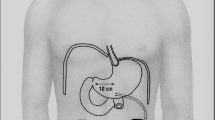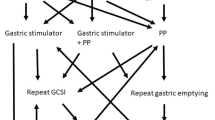Abstract
Background
Gastroparesis is a disabling, and sometimes fatal, disease that often does not respond to medical treatment. This single-surgeon prospective study examines the safety and 6-month efficacy of electrical stimulation for the treatment of gastroparesis.
Methods
Sixteen patients with medically refractory gastroparesis underwent laparoscopic implantation of an electrical stimulator device (Enterra Therapy, Medtronic, Minneapolis, MN, USA) consisting of a subcutaneous stimulator and two gastric wall leads. Gastric emptying scans (GES) confirmed the diagnosis of gastroparesis. Patients were evaluated preoperatively using a self-administered GI symptomatology questionnaire and RAND 36 Health Survey. Once patients were >6-months from implantation, a repeat GES was obtained and patients completed a postoperative GI symptomatology questionnaire and RAND 36 Health Survey. Ten of 16 patients in this case series were >6-months from implantation. One was lost to follow-up. An F-test was used to establish equality of standard deviations between the 16 patients evaluated preoperatively and the subset of 10 patients evaluated postoperatively. A Student’s t-test was used to evaluate the significance of differences in pre- and postoperative results.
Results
Average operating time was 117 min with no intraoperative complications. The majority of patients were discharged on postoperative day 1. There were two complications in the postoperative period. Patients experienced a significant decrease in nausea and vomiting as measured by the GI symptomatology questionnaire. Half of all patients no longer required gastric prokinetic medications and there was a subjective reduction of pyrosis, early satiety, and epigastric pain. A significant increase in quality of life as measured by the RAND 36 Health Survey was seen, and six of eight patients no longer demonstrated gastroparesis on GES.
Conclusion
Laparoscopic implantation of an electrical stimulation device is a safe and effective treatment by subjective and objective standards for the management of medically refractory gastroparesis.



Similar content being viewed by others
References
Abell TL, Hocking M, McCallum RW, Koch K, Nowak T, Dibaise JK (2001) Long term hospitalization outcomes and economic impact of gastric electrical stimulation in patients with drug-refractory gastroparesis. Gastroenterology 120: A408
Abell T, Lou J, Tabbaa M, Batista O, Malinowski S, Al-Juburi A (2003) Gastric electrical stimulation for gastroparesis improves nutritional parameters at short, intermediate, and long-term follow-up. J Parenter Enteral Nutr 27: 277–281
Abell T, McCallum R, Hocking M, Koch K, Abrahamsson H, LeBlanc I, Lindberg G, Konturek J, Nowak T, Quigley EM, Tougas G, Starkebaum W (2003) Gastric electrical stimulation for medically refractory gastroparesis. Gastroenterology 125: 421–428
Abell TL, Van Cutsem E, Abrahamsson H, Huizinga J, Konturek JW, Galmiche JP, Voeller G, Filez L, Everts B, Waterfall WE, Domschke W, Des Varannes SB, Familoni BO, Bourgeois IM, Janssens J, Tougas G (2002) Gastric electrical stimulation in intractable symptomatic gastroparesis. Digestion 66: 204–212
de Csepel J, Goldfarb B, Jordan C (2003) Gastric electrical stimulation: a novel treatment for gastroparesis. Pract Diabetol 22: 14–18
Devendra D, Millward BA, Travis SP (2000) Diabetic gastroparesis improved by percutaneous endoscopic jejunostomy. Diabetes Care 23: 426–427
Eckhauser FE, Conrad M, Knol JA, Mulholland MW, Colletti LM (1998) Safety and long-term durability of completion gastrectomy in 81 patients with postsurgical gastroparesis syndrome. Am Surg 64: 711–716
Fontana RJ, Barnett JL (1996) Jejunostomy tube placement in refractory diabetic gastroparesis: a retrospective review. Am J Gastroenterol 91: 2174–2178
Forster J, Sarosiek I, Delcore R, Lin Z, Raju GS, McCallum RW (2001) Gastric pacing is a new surgical treatment for gastroparesis. Am J Surg 182: 676–681
Forster J, Sarosiek I, Lin Z, Durham S, Denton S, Roeser K, McCallum RW (2003) Further experience with gastric stimulation to treat drug refractory gastroparesis. Am J Surg 186: 690–695
Hays RD, Morales LS (2001) The RAND 36 measure of health-related quality of life. Ann Med 33: 350–357
Hoogerwerf WA, Pasricha PJ, Kalloo AN, Schuster MM (1999) Pain: the overlooked symptom in gastroparesis. Am J Gastroenterol 94: 1029–1033
Jones MP, Maganti K (2003) A symptomatic review of surgical therapy for gastroparesis. Am J Gastroenterol 98: 2122–2129
McCallum RW, Chen JD, Lin Z, Schirmer BD, Williams RD, Ross RA (1998) Gastric pacing improves emptying and symptoms in patients with gastroparesis. Gastroenterology 114: 456–461
Ogorek CP, Davidson L, Fisher RS, Krevsky B (1991) Idiopathic gastroparesis is associated with a multiplicity of severe dietary deficiencies. Am J Gastroenterol 86: 423–428
Rabine JC, Barnett JL (2001) Management of the patient with gastroparesis. J Clin Gastroenterol 32: 11–18
Soykan I, Siviri B, Sarosiek I, Kiernan B, McCallum RW (1998) Demography, clinical characteristics, psychological and abuse profiles, treatment, and long-term follow-up of patients with gastroparesis. Dig Dis Sci 43: 2398–2404
Sturm A, Holtmann G, Goebell H, Gerken G (1999) Prokinetics in patients with gastroparesis: a systematic analysis. Digestion 60: 422–427
Tack J, Coulie B, Van Cutsem E, Ryden J, Janssens KU (1999) The influence of gastric electrical stimulation on proximal gastric motor and sensory function in severe idiopathic gastroparesis. Gastroenterology 116: G4733
Thomforde GM, Camilleri M, Phillips SF, Forstrom LA (1995) Evaluation of an inexpensive screening scintigraphic test of gastric emptying. J Nucl Med 36: 93–96
Tougas G, Eaker EY, Abell TL, Abrahamsson H, Boivin M, Chen J, Hocking MP, Quigley EM, Koch KL, Tokayer AZ, Stanghellini V, Chen Y, Huizinga JD, Ryden J, Bourgeois I, McCallum RW (2000) Assessment of gastric emptying using a low fat meal: establishment of international control values. Am J Gastroenterol 95: 1456–1462
Tougas G, Huizinga JD (1998) Gastric pacing as a treatment for intractable gastroparesis: shocking news? Gastroenterology 114: 598–601
Author information
Authors and Affiliations
Corresponding author
Rights and permissions
About this article
Cite this article
de Csepel, J., Goldfarb, B., Shapsis, A. et al. Electrical stimulation for gastroparesis. Surg Endosc 20, 302–306 (2006). https://doi.org/10.1007/s00464-005-0119-4
Received:
Accepted:
Published:
Issue Date:
DOI: https://doi.org/10.1007/s00464-005-0119-4




